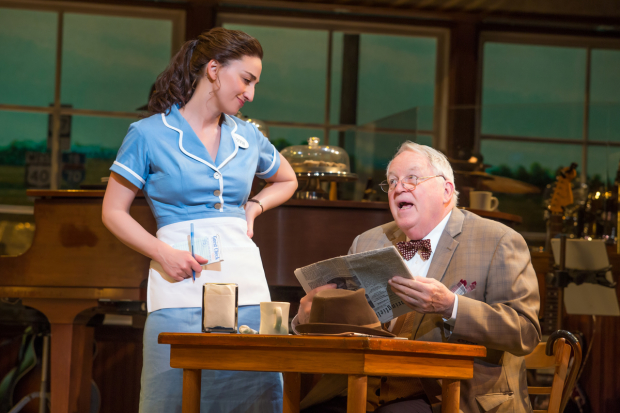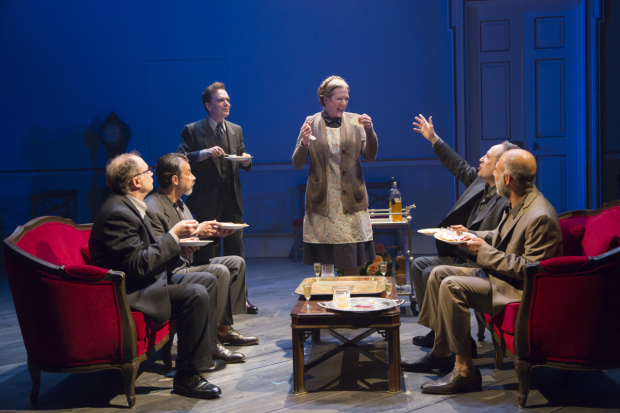When Broadway Actors Sit Down for an Onstage Meal, Who Makes the Food?

(© Jeremy Daniel)
It's a common-enough sight in the theater: The actors gather around a table for a hearty meal, often seasoned with subtext and shade. Prop food is decidedly out of fashion on Broadway (unless you have a comedian like Bette Midler to really sell that plastic turkey leg, as she does in Hello, Dolly!). Dining scenes require a fresh meal for every performance, but who's making all that food? One rarely sees a chef listed alongside the designers (downtown's pie-shop Sweeney Todd is a major exception), meaning that the role of food designer usually falls to someone a bit farther back in the program.
In the case of the popular Broadway musical Waitress, that person would be pie consultant Stacy Donnelly, a former dancer and the proprietor of Cute as Cake, a bakery that specializes in cakes sculpted into things that don't usually come in cake form. "I met [producers] Fran and Barry Weissler when I did the opening-night cake for Pippin," Donnelly says of her role feeding Broadway's insatiable desire for celebratory cake. "When they started working on Waitress, they asked me if I made pies as well. I started consulting with them to figure out how to make the pies a real experience in the show."
Hundreds of stage pies and over 65,000 pie jars later (bite-size pies available for sale in the lobby), Donnelly is still at it. At this point, she's figured out exactly how many pies she needs to bake in order to maintain freshness without wasting food: "There's four every week: A blueberry pie, an apple pie, a pecan pie, and a cheese pie for Dakin."

(© Jeremy Daniel)
Dakin Matthews, who plays the owner of the pie diner in which the musical takes place, is the only actor to actually chow down during the show. He had been eating blueberry pie eight times a week, but his palate soon grew weary of the fruit confection. "Stage management called and said that he'd like to try something savory," explains Donnelly on how she landed the idea of cheese. "We gave him a few options that would look right in the scene, and this is the one he liked best."
Since the audience will never actually taste the pies onstage, aesthetic is everything. "The job is about piecing together the recipes mentioned in the script and figuring out how to make them look as delicious as possible," Donnelly explains. "If something is all white onstage, it's going to wash out in the lights, so a creamy pie needs to be garnished with chocolate or something that is going to give it dimension." Stage lights are the constant menace of the food designer. "One of my biggest challenges is making sure the whipped cream doesn't melt," says Donnelly.
Karl Rausenberger sympathizes. He's the head production propertyman at Lincoln Center Theater, and it is his job to prepare the waffles at every performance of Oslo, J.T. Rogers' play about how Israelis and Palestinians negotiated peace over scotch and waffles in a Norwegian castle. "I set my timer exactly so the whipped cream and jam doesn't melt before it goes out onstage," he says.
It's all in the timing for Rausenberger, who supervises the movement of the props and furniture onstage while grilling up five heart-shaped waffles each performance. "I heat up the iron for 10 minutes at the top of the show. Then I start to cook. It's 3 minutes per waffle, so they all come out exactly the same."

(© T. Charles Erickson)
The look of the plate is just as crucial to Rausenberger as it is to Donnelly. "I can hear Henny doing the speech about the waffles backstage, and it's in my head while I'm making them. This has to look like her mom's recipe," he says. Henny Russell, who plays housekeeper Toril Grandal, describes her own mother's waffle recipe when she carts them out for the delegates. Rausenberger doesn't have quite enough time to follow that exact recipe, which includes separating the eggs and sprinkling in light dashes of cardamom. "I use Aunt Jemima Complete," he confesses.
Even if he's just pouring box mix into a Norwegian waffle iron, Rausenberger takes a certain amount of pride in his creation: "The cast tells me they taste better than the way they did downstairs," he brags, implicitly challenging the other Lincoln Center propertymen to a waffle-off (Oslo started last summer in LCT's off-Broadway theater, the Mitzi E. Newhouse). "I don't know what the difference is, but the smell backstage is just ridiculous," he notes, referring to the waffles' alluring aroma.
Donnelly has harnessed the smell of her pies into an olfactory overture for the audience of Waitress. Thirty minutes before the theater opens, an apple pie goes into a convection oven in the lobby, sending the scent wafting over the house. "Apple pie is very much a comfort smell to most people," she says. "You come in and automatically have a warm, fuzzy feeling." Considering that smell is the sense most closely attached to memory, we very much approve of the emerging art of smell design in the theater.
Rausenberger has some experience with olfactory elements onstage as well: "In 2003 we did a show called Vincent in Brixton and they cooked a leg of lamb during the show. Lamb has a pretty potent smell, and it filled the whole house." While it must have been a challenge to clear the Vivian Beaumont of that kebab-shop fragrance, Vincent in Brixton pales in comparison to the theatrical event that Rausenberger considers his Everest.

(© Paul Kolnik)
"When we did The Coast of Utopia 10 years ago, I had an entire kitchen setup backstage. There were multiple refrigerators on our loading dock," he says, recalling the gargantuan task of preparing food for the trilogy of plays about hungry 19th-century Russian intellectuals. The experience turned him into a one-man kitchen line: "I would set up a plate, microwave it, and send it out on this big rolling table steaming hot, like a real dinner."
The show is the yardstick by which Rausenberger measures all other jobs. "When my production manager comes in and tells me that my crew and I are going to be busy on the next show, I say, 'You can't scare me: I did Coast of Utopia.'"












